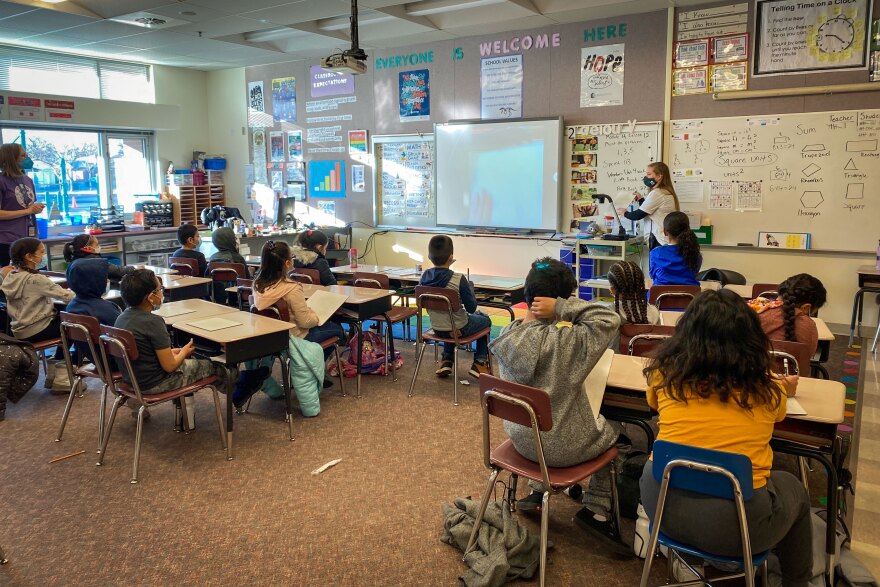It’s 7:55 a.m. on a Friday morning in early January, the first week back after the winter break. This is the last day of what’s been the craziest week in Nicole Palmer’s 11 years as principal of Rose Park Elementary School.
She’s been up for three hours already and now the kids at the school on Salt Lake City’s west side are starting to arrive.
“We have two counselors out — two of three — two teachers, the librarian,” Palmer said, taking stock of the day’s damage with Assistant Principal Tony Zani. He pointed out the school was missing its secretary too.
“We have our custodian back,” Palmer said on a hopeful note. “He was out yesterday.”
This was the most mellow day of the week so far, in terms of absences. Palmer didn’t have to teach that Friday, which she did earlier this week. Instead, she and others had to take shifts covering the office.
The shuffling has been the perpetual struggle during the pandemic — the ripple effect when anyone is out and others have to step in. All but the most pressing tasks are pushed off to the next day, the next week or even the next school year.

“Every morning I just make sure I'm up in time,” she said. “I check before I go to bed. Then I check in the morning. Are two people out? Are eight people out? We haven’t quite had eight yet. We’ve had six.”
By this week, that changed. Eight people were out Wednesday, including five teachers. More than a third of her students — 92 — were also absent that day.
The Salt Lake City School District, along with Alpine and Canyons, switched several schools to remote classes after at least 2% of the student population tested positive and the state continues to rack up record numbers of COVID-19 cases.
Palmer said the biggest issue now is the lack of substitute teachers, which has never been worse. For a while, the school was not even requesting them, knowing they wouldn’t get any. Palmer said she only started to request them again recently just so the district can track the data.
External calm, internal pressure
Walking through the hallways of the elementary school, there is no visible chaos. Students aren’t running around screaming and things look pretty normal in the classroom.
Palmer stepped into a fourth grade classroom asking kids if they “remembered what it was like before COVID.” One student said those were the golden years.
Now, that all seems like a distant memory, especially for third grade teacher Cara Cerise.
She said on top of the staffing issues — and the day-to-day scrambling it requires — there’s also the compounding stress that’s been simmering over the last three pandemic school years.
Cerise said she tries to go easy on herself, but she can’t just not care because her students depend on her.
“We're just barely keeping it together and trying to avoid a burst,” she said. “That feels like one of the scariest parts is: will the system collapse? How many teachers and instructors can actually be out and you still can run a school?”

Cerise said she missed her uncle’s funeral that day because she felt like she owed it to her colleagues and students to stick around. Another teacher, Amelia Landay, said she’s reaching a breaking point.
“That resignation notice looks real good right now,” Landay said.
First grade teacher Cassandra Gaisford said it’s clear her students need a break too. She had just half of her students in class that day. Some that do show up have to be sent home for illness. One threw up in the classroom the day before.
When her students are there, Gaisford said they have a hard time staying focused. She finds she has to spend a lot of time just helping them with basic interactions, pushing any academic learning to the side.
“Our first graders this year who were on remote learning most of last year, they came to us like kindergartners,” she said. “And they've had a really hard time learning how to treat each other. They're always offended.”
The show goes on
Meanwhile, most of the usual requirements are back this year. Last year, students still took standardized tests, but teachers had more time to get them done. This year, it’s pretty much back to normal.
John Olson, a sixth grade teacher, said that’s added pressure on educators who are accountable for their students’ success.
“Most people have their job and they're responsible for their content,” Olson said. “With a teacher, you have more than one person involved. You have the students and you have the parents. And at the end of the year, if a student fails, it's all on the teacher.”
At least, he said, this year has been fast-paced. He said it’s also made him a better teacher, forcing him to adapt and get better with technology in the classroom.
And hopefully, he said, this latest COVID surge is the final sprint towards the finish line of the pandemic.

Palmer tried to look for the positives too. She said she ended the week feeling grateful, seeing the teachers and staff so willing to help each other out.
They’re tired, they’re burnt out, but they haven’t given up.
“It’s kind of like two ends,” she said. “Today, we are here, we are smiling, our kids are good. And we are short staffed. And you have to think from that 30,000-foot level of how will this impact education now, this summer, in the future?”
But that’s a worry for another day.


